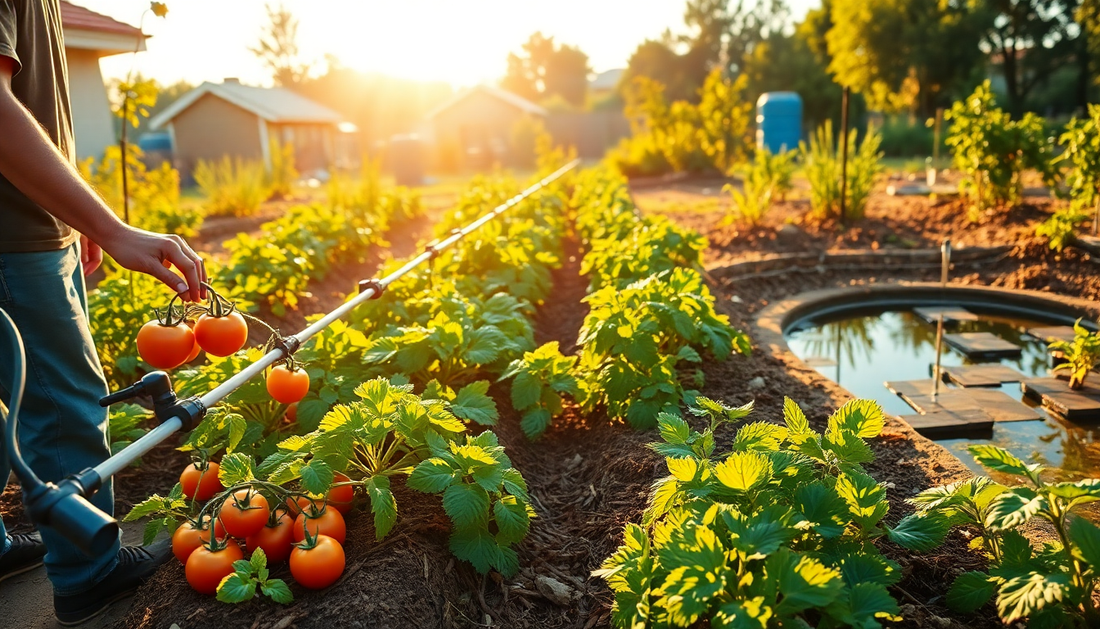
Water-Saving Tips for Vegetable Gardens
Share
As the world grapples with the challenges of climate change and water scarcity, it's more important than ever to adopt sustainable gardening practices. If you're a vegetable gardener, you can play a crucial role in conserving this precious resource. In this comprehensive blog post, we'll explore a range of water-saving techniques that can help you grow a thriving vegetable garden while minimizing your water usage.
Understanding Water Needs in Vegetable Gardens
Vegetables have varying water requirements, and it's essential to tailor your watering practices to the specific needs of the plants in your garden. Some vegetables, such as tomatoes, peppers, and leafy greens, require more frequent watering, while others, like squash and root vegetables, can tolerate slightly drier soil. By understanding the water needs of your chosen vegetables, you can optimize your irrigation strategies and avoid over- or under-watering.
Assessing Soil Moisture
One of the most crucial steps in water-saving gardening is regularly checking the soil moisture levels. This can be done by simply sticking your finger into the soil up to the second knuckle. If the soil feels dry, it's time to water. Alternatively, you can use a soil moisture meter to get a more precise reading. By monitoring soil moisture, you can ensure that your plants are receiving the right amount of water, preventing waste and promoting healthy growth.
Choosing Drought-Resistant Varieties
When planning your vegetable garden, consider selecting varieties that are known to be drought-resistant. These plants are often adapted to thrive in drier conditions and require less water to maintain their health. Some examples of drought-tolerant vegetables include:
- Tomatoes
- Peppers
- Squash
- Beans
- Carrots
- Beets
By incorporating these types of vegetables into your garden, you can reduce your overall water consumption while still enjoying a bountiful harvest.
Irrigation Strategies for Water Conservation
Efficient irrigation is the key to water-saving gardening. There are several irrigation techniques you can employ to maximize water usage and minimize waste.
Drip Irrigation Systems
Drip irrigation systems are one of the most effective ways to water your vegetable garden. These systems deliver water directly to the root zone of the plants, reducing evaporation and ensuring that the water is used efficiently. Drip irrigation can save up to 70% of the water used in traditional sprinkler systems.
Soaker Hoses
Soaker hoses are another excellent option for water-saving gardening. These hoses slowly release water along their length, allowing the soil to absorb the moisture gradually. This method reduces water waste and ensures that the water reaches the plant roots where it's needed most.
Rainwater Harvesting
Capturing and using rainwater is an excellent way to supplement your vegetable garden's water supply. By installing rain barrels or other rainwater harvesting systems, you can collect and store water for later use, reducing your reliance on municipal or well water sources.
Mulching
Applying a layer of organic mulch, such as wood chips, leaves, or straw, around your vegetable plants can significantly reduce water evaporation from the soil. Mulch helps to retain moisture, keeping the soil moist for longer periods and reducing the need for frequent watering.
Watering Techniques
The way you water your vegetable garden can also impact water conservation. Consider the following techniques:
- Water in the early morning or late evening to minimize evaporation.
- Water deeply and less frequently, encouraging deeper root growth and reducing the need for frequent watering.
- Use a watering can or a low-pressure hose to water individual plants, rather than spraying the entire garden.
- Avoid overhead watering, which can lead to water loss through evaporation and wind.
Maintaining a Healthy Vegetable Garden
Proper garden maintenance is essential for water-saving gardening. By keeping your vegetable garden healthy and thriving, you can reduce the need for excessive watering.
Soil Preparation
Amending your soil with organic matter, such as compost or well-rotted manure, can improve its water-holding capacity. This helps the soil retain moisture more effectively, reducing the frequency of watering.
Weeding and Pest Control
Keeping your vegetable garden free of weeds is crucial for water conservation. Weeds compete with your vegetables for water and nutrients, so removing them regularly can help your plants thrive with less water. Additionally, maintaining healthy plants through proper pest control measures can reduce the stress on your vegetables, making them more resilient and less water-dependent.
Crop Rotation and Companion Planting
Rotating your vegetable crops and incorporating companion planting techniques can also contribute to water-saving gardening. Certain plant combinations can help retain soil moisture, while crop rotation can prevent the depletion of specific nutrients and water-soluble minerals.
Conclusion
Implementing water-saving strategies in your vegetable garden is not only an environmentally responsible choice but can also lead to a more productive and resilient growing space. By understanding your plants' water needs, utilizing efficient irrigation methods, and maintaining a healthy garden, you can significantly reduce your water consumption while enjoying a bountiful harvest. Remember, every drop of water saved makes a difference in the long-term sustainability of our planet.
